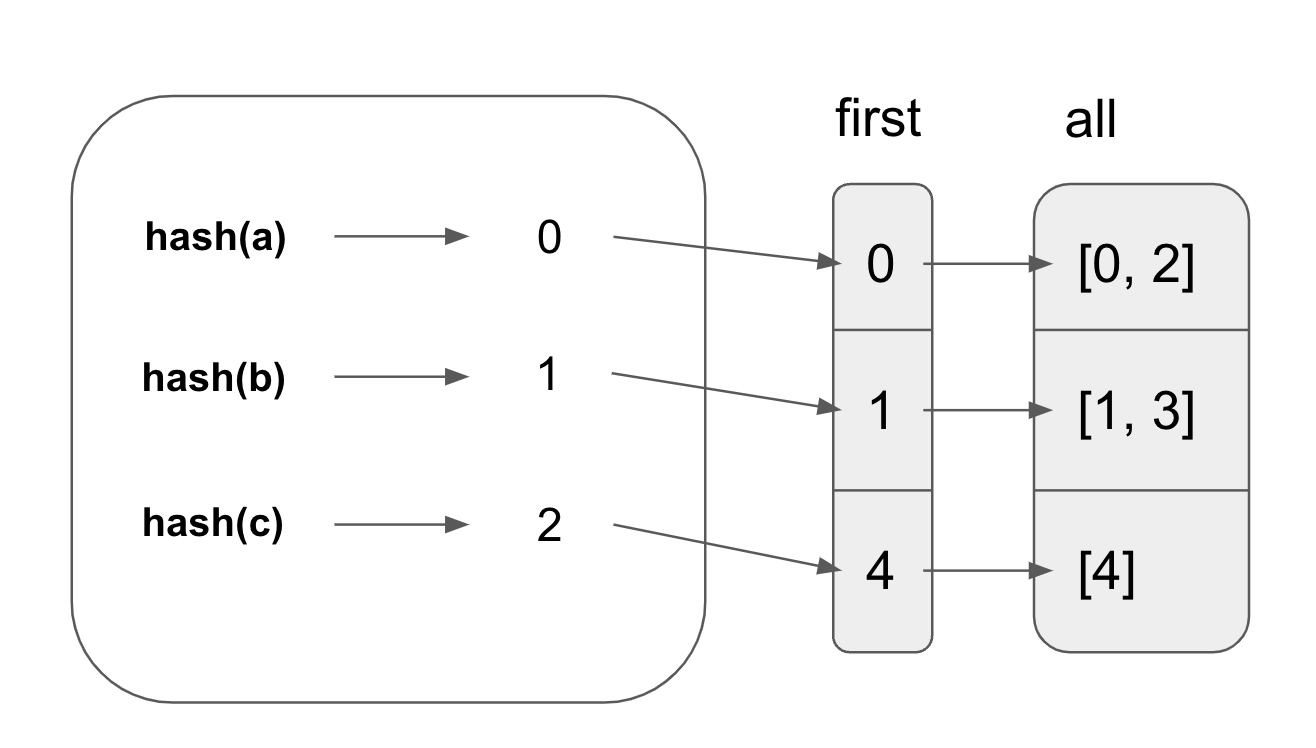Groupby
GroupBy is an operation that allows people to group records based on certain attributes and perform aggregations on those groups. It is often used in combination with aggregate functions like SUM, COUNT, etc to summarize information for each group.
Here’s an example of GroupBy:
#![allow(unused)] fn main() { let df = df![ "name" => ["a", "b","a", "b", "c"], "points" => [1, 2, 1, 3, 3] ] let res = df .lazy() .groupby(vec!["name"]) .agg(vec![col("points").sum()]) .collect(); }
In this example, we group rows by the name column and aggregate the sum for each group. This would yield the dataframe:
| name | points |
|---|---|
| a | 2 |
| b | 5 |
| c | 3 |
GroupProxy
When developers perform df.groupby(...), they actually get back a GroupProxy, a temporary data structure that stores information about which rows belong to which groups. The most common variant of GroupProxy is GroupsIdx. This is its definition:
#![allow(unused)] fn main() { pub struct GroupsIdx { first: Vec<u32>, all: Vec<Vec<u32>>, } }
The indices of the rows belonging to the same group are stored together in the all vectors. The first index of each group is stored in the first vector.
If we look at the example:
#![allow(unused)] fn main() { let df = df![ "name" => ["a", "b","a", "b", "c"], "points" => [1, 2, 1, 3, 3] ] let group_idx = df .lazy() .groupby(vec!["name"]); }
In the example provided above, the GroupIdx is:
#![allow(unused)] fn main() { { first: [0, 1, 4], all: [ [0, 2], // indices of rows with col("name") = "a" [1, 3], // indices of rows with col("name") = "b" [4]. // indices of rows with col("name") = "c" ] } }
If there are multiple groupby keys, the same logic applies:
#![allow(unused)] fn main() { let df = df![ "name" => ["a", "b","a", "b", "c"], "points" => [1, 2, 1, 3, 3] ] .unwrap(); let groupby = df.groupby(vec!["name", "points"]).unwrap(); }
In this example, the GroupProxy is:
#![allow(unused)] fn main() { { first: [0, 1, 3, 4], all: [ [0, 2], // indices where col("name") = "a" & col("points") = 1 [1], // indices where col("name") = "b" & col("points") = 2 [3], // indices where col("name") = "b" & col("points") = 3 [4] // indices where col("name") = "c" & col("points") = 3 ] } }
Hash Group By
Polars uses hash group by to compute the GroupProxy for a dataframe given a set of group keys. This is very similar to the parallel hash join algorithm presented earlier. The overall idea is to use a hash table to group indices with the same group by keys.
Polars first computes the hashes for the by columns with the vectorized hashing technique that Hash Join uses.
Next, Polars parallelizes the creation of hash tables with the same modulo trick mentioned in the last section. Every thread traverses all hashes and ignores the ones that doesn’t belong to that thread.
Instead of storing the indices inside the hash table, the hash table stores the index of the all vector. The algorithm iterates through the hashes. If there is a matching entry in the hash table for a group key, it uses the index stored in the hash table to find the other indices in the same group in all and adds itself to it. Otherwise, it adds a new entry to the hash table and adds itself to the first and all vectors.
Given the earlier example:
#![allow(unused)] fn main() { let df = df![ "name" => ["a", "b","a", "b", "c"], "points" => [1, 2, 1, 3, 3] ] let res = df .lazy() .groupby(vec!["name"]) }
The figure below shows that the hash table stores the indices that correspond to the first and all tables.

Parallel Flattening
Since Polars parallelizes the grouping of rows, each thread creates a first and all vector. Thus, we end up with Vec<(Vec<IdxSize>, Vec<Vec<IdxSize>>)>. To create the GroupProxy, we need to flatten the vector.
The goal of flattening is to turn Vec<Vec<...>> into Vec<...>. Copying the elements one by one into the output vector may be slow when the number of elements is large. Polars utilizes available threads to flatten the array in parallel.
Polars guarantees that the output vector will not reallocate by initializing the output vector’s capacity to the exact size it will end up in. This makes it safe to parallelize the copying of individual vectors into the output vector. The capacity can be computed by summing up the sizes of the smaller vectors.
Each smaller vector needs to know the address to copy the values into. The offsets are pre-computed and the final address is derived from: first.as_mut_ptr().add(offset).
In Rust, mutable pointers does not implement the Sync trait so Rust will complain that *mut u32 cannot be shared between threads safely when using Rayon. Polars wraps the mutable pointer with a SyncPtr struct. The SyncPtr struct allows sending pointers to other threads when the developer is confident that the pointer will point to valid address.
#![allow(unused)] fn main() { pub struct SyncPtr<T>(*mut T); unsafe impl<T> Sync for SyncPtr<T> {} unsafe impl<T> Send for SyncPtr<T> {} }
Finally, Polars uses std::ptr::copy_nonoverlapping to copy value from the smaller Vecs to the new Vec.
I will talk about how Groupby is composed with aggregate functions in the LazyFrame section.